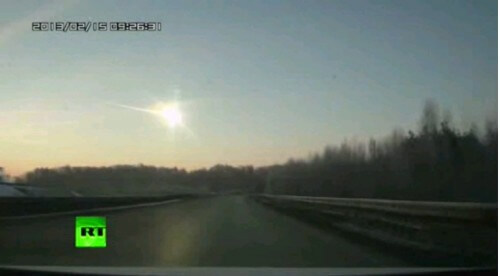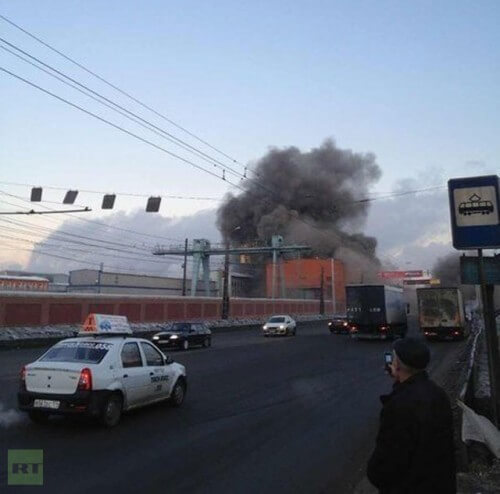Initial reports on the Russian television station RT indicate that a fragment of the meteorite fell and crashed near the fence of a zinc factory, disrupting internet and cell phone services in the city

By an interesting coincidence, the event happened on the same day as expected A large asteroid to pass near Earth.
Reports from Russia tell of a bright meteor that exploded with a loud noise in Russia, and a very large number of videos showing what appears to be a meteor explosion in the atmosphere this morning Friday, 15/2/2013
Update, at 17:00, the news agencies report that the number of injured has reached 950. Another update, on Saturday the authorities in Russia report on 1,350 wounded who arrived at medical centers and requested treatment for their wounds.
According to reports, the explosion occurred over the cities of Chelyabinsk, Tyumen and Sverdlovsk, the Russian Republic of Ashkiria and northern Kazakhstan. The Russian news agency quotes from the mouth of the rescue forces on the spot that according to the information in his hands, the explosion took place at a height of about 10 kilometers from the ground. Chelyabinsk lies about 1,500 kilometers east of Moscow in the Ural Mountains.
A meteorite is a fragment of rock that has broken off from space objects such as asteroids and comets, and its size varies from a grain of dust to a huge rock. When a meteorite falls to the earth, it passes through the atmosphere and causes it to heat up and emit a trail of light, thus creating the fireball known as a meteor - a falling star.
.
Anti-IDF units were put on high alert. Because the explosion happened at an altitude of several kilometers and it is necessary to check large areas to see if they were affected by radiation or toxic substances from the factories in the area.
Initial reports on the Russian TV station RT indicate that a fragment of the meteorite fell and crashed near the fence of a zinc factory, disrupting internet and cell phone services in the city. It was also reported that 500 were slightly injured from broken glass caused by the shock wave of the explosion. (This number climbed the following day to over 1,300, when more wounded arrived for treatment).

The Russian army was called to the area to assist in rescue operations. Army units are searching for remnants of the meteorite in several places, including in an area near a military base located near Lake Chabarkol, west of Chelyabinsk. Another area where searches are being conducted is near the city of Kusa, about 80 kilometers northwest of the area.
Three military planes were launched to scan the area and look for additional hit sites.
Witnesses reported that the explosion was so powerful that it appeared as if an earthquake and thunder struck the ground at the same time, and huge plumes of smoke were seen in the sky. Some of the reports also stated about burning objects that fell to the ground.
The emergency center of the Ural region claims to have sent out a huge amount of SMS messages warning the residents of a meteorite shower, but the residents say that they did not receive it, and some received it late, after the explosion had already occurred.
Another event like Tongska?
The current event has drawn comparisons to the Tungaska event of 1908 - a particularly powerful explosion over Siberia caused by a remnant of a comet or meteor. According to estimates, the energy in the Tongska explosion reached 50 megatons of TNT, that is, with an intensity similar to that of a nuclear explosion. About 80 million trees were uprooted in an area of 2,000 square kilometers. The Tunguska explosion remains one of the great mysterious events of the 20th century. It is estimated that if the Tungaska event had occurred four hours later, it would have completely destroyed the city of Vyborg and fatally damaged St. Petersburg due to the rotation of the Earth.
When a similar event, albeit with a much weaker intensity, occurred in Brazil in 1930, it was nicknamed the Brazilian Tungaska. The Tungaska event also spurred public debate and research about asteroid impact prevention on Earth.
For the news in Universe Today - together with some of the films that were shot in the field

20 תגובות
The missile does not have to chase the meteorite - only collide with it - from another direction.
In the meantime: the 2 videos in which the runners (of the missiles - on the left side) were seen - were edited and their names that explicitly indicated the Russian Air Force strike (they were on the top right) - were changed.
In another video we even see for a few seconds, in my opinion, a plane flying parallel to the asteroid's trail - apparently immediately after the impact.
The first 42 seconds are the interesting ones.
http://www.youtube.com/watch?NR=1&feature=endscreen&v=Rp5eg_lk8zA
On the other hand, on another thought, since there is not much documentation of meteorites of this size, breaking into the atmosphere - it is difficult to compare with the pictures on the Internet, which show much smaller meteorites.
Hello everyone and Liniv,
It was announced that the asteroid reached a speed of 57,000 km/h or about 30 kilometers per second.
I don't know if it's accurate but 57,000 km/h is about Mach 57.
The escape velocity from Earth is approximately Mach 8 and I don't think there is an interceptor missile that approaches Mach 57. Unless the body moves in a straight line for hundreds of kilometers there is no interceptor missile in the world that can reach this body and intercept it.
My father, there is actually some sense in this, after all, superpowers like Russia and the USA have sophisticated defense systems that are supposed to detect bodies that are rapidly approaching the continent (ballistic missiles, etc.) and shoot them down, I see no particular reason why such a missile that knows how to lock onto fast bodies using radar or through Heat detection will not be able to home in on such a meteorite and destroy it.
Is there an estimate of its speed until it hits the ground?
There is a rumor that a missile was sent to intercept the meteor, I doubt that is even possible.
The photographs of the smoke trail are similar to the trails of a jet plane and not to other photographs of meteors. The title of the YouTube video is about the attack by the Russian Air Force.
To me, the photos remind me of the impact trail of a Patriot missile actually in the air. Maybe it's the Russian equivalent of "patriot".
The splitting of the meteorite into several parts is also reminiscent of a Patriot strike.
In Russia, insurance companies require drivers to install a camera in their vehicle
איציק
Forget cameras, how come there are so many Adidas tracksuits.
Thanks. fixed
In Russia there is quite a rich layer.
In his video, you can see that the explosion was right above them and it took about half a minute before they heard it, so this supports the claim that it was at an altitude of 10 km"
http://www.youtube.com/watch?feature=endscreen&v=nsNPIyxwPlE&NR=1
two questions
1. What was the size of the bone in question?
2. How come there are so many cars with cameras in Russia?
And as usual they hide the truth from the public.
And what is the truth? This morning the Earth was the target of a very sophisticated weapon test that was sent to us through a wormhole by some alien population from a distant planet. The heads of government and the parties involved know this. It is still not clear what message they tried to convey to us through the attack.
Get ready for developments on the subject.
In the attached picture it says 2012 instead of 2013. This caused me and maybe others to look for another event from a year ago, so please correct
The moment of hitting the camera lens - http://www.youtube.com/watch?v=TtOL5OiWTNI
You can clearly hear the explosion, the breaking glass and the car alarms.
Scary..